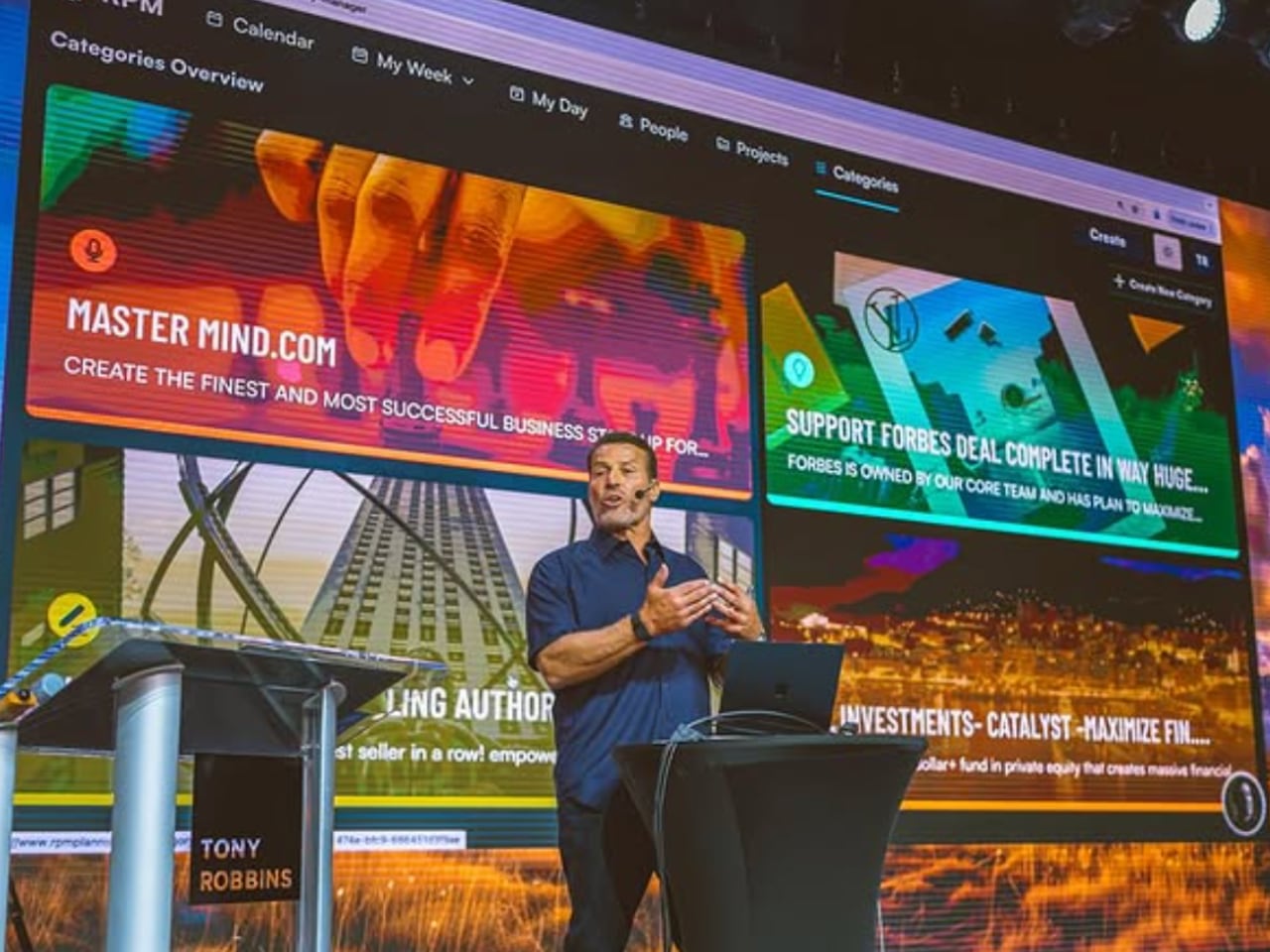Artificial intelligence has transcended mere buzzwords, emerging as a pivotal force reshaping our global landscape. According to McKinsey, AI is set to automate 30% of work hours across 60% of occupations by 2025. This rapid change often breeds uncertainty and fear. However, as Tony Robbins asserts, within every seismic shift lies the potential for equal or greater opportunity. “The quality of your life is in direct proportion to the amount of uncertainty you can comfortably live with,” Robbins emphasizes. His decades-long exploration of human potential and transformation has led him to identify three crucial patterns for navigating times of upheaval: pattern recognition, pattern utilization, and pattern creation. Mastering these patterns transforms technological disruption from a looming threat into a powerful catalyst for personal and professional growth.
In Tony Robbins’ annual Time to Rise Summit, Day 1 comes alive with these insights. Here, Robbins delves into the essence of thriving amidst transformation, sharing concrete strategies and real-life applications. He encourages individuals to harness change and leverage new patterns, unlocking paths to success in the AI-driven era. The detailed concepts presented during the summit serve as a guide and an invitation to embrace change fearlessly. For those eager to delve deeper into this transformative knowledge, the full session titled Time to Rise Summit Day 1: Break Through in 2025! is available here: Watch the Summit.
Understanding AI Patterns: The Foundation of Transformation
As Robbins teaches, pattern recognition is the ability to see order where others see chaos. In the context of AI, this skill becomes particularly crucial. Emily Chen’s experience at Accenture illustrates this principle perfectly. As Head of Digital Transformation, Chen initially saw AI as a complex challenge threatening her team’s traditional workflows. However, by applying Robbins’ pattern recognition methodology, she identified recurring patterns in her team’s work that could be enhanced rather than replaced by AI.
“Success leaves clues,” Robbins often says. Chen’s solution proved this maxim. By implementing ChatGPT Enterprise for project documentation and Anthropic’s Claude 2 for strategic analysis, her team’s productivity soared by 300%. More importantly, they discovered what Robbins calls “breakthrough patterns” – ways of working that fundamentally transform results.
This pattern recognition extends across industries. At Mayo Clinic, machine learning diagnostics now analyze medical images with unprecedented accuracy, reducing error rates by 47%. JPMorgan’s AI-driven fraud detection processes 12 billion transactions annually. These aren’t just statistics – they’re patterns of possibility that show us where human potential can be amplified by AI.
Leveraging AI Patterns: From Recognition to Results
Robbins teaches that recognizing patterns is only the first step – the real power comes from utilizing them strategically. This principle is powerfully demonstrated in modern business transformations. Microsoft’s integration of GPT-4 into its business suite shows how AI can augment human capabilities rather than replace them.
Consider Marcus Rodriguez, a small business owner who exemplifies Robbins’ principle of pattern utilization. Rodriguez didn’t just recognize AI patterns – he leveraged them strategically. By integrating AI analytics into his decision-making process, he increased sales by 156% while reducing operational costs. His approach mirrors Robbins’ teaching that success comes from turning knowledge into action.
“Knowledge is not power,” Robbins states. “Knowledge is potential power. Action is power.” This principle guides successful AI integration across industries:
- Sales teams using Salesforce Einstein and HubSpot’s AI suite have increased conversion rates by 45%
- Legal departments implementing AI-driven contract analysis have reduced review time by 70%
- Marketing teams utilizing AI content tools have improved campaign effectiveness by 78%
Creating New Patterns: The Ultimate Power
Pattern creation represents what Robbins calls “the ultimate power” – the ability to shape reality rather than merely respond to it. Sarah Martinez’s transformation of her Fortune 500 company exemplifies this principle. As CTO, she faced what Robbins identifies as a common limiting belief: that technological change threatens human value. Her response wasn’t just to adapt to AI – she created new patterns of integration that enhanced human potential.
“Anticipation is power,” Robbins teaches. Martinez’s approach embodied this wisdom. She developed a comprehensive AI integration framework that achieved a 200% increase in departmental efficiency while maintaining employee satisfaction above 90%. This wasn’t just change management; it was pattern creation in action.
The key to Martinez’s success lay in applying Robbins’ three-step pattern creation process:
- Identify current limitations and opportunities
- Design new approaches that transcend existing boundaries
- Implement and refine until breakthrough results are achieved
Implementation Strategy: The Power of Massive Action
“Taking massive action is the cure to all fear,” Robbins emphasizes. Harvard Business Review’s research supports this principle, showing that organizations with structured implementation plans achieve 3.5x better results than those without clear strategies. This isn’t coincidental – it’s a pattern of success that can be replicated.
The journey begins with what Robbins calls “honest self-evaluation.” Organizations must assess their AI literacy levels and identify high-impact implementation areas. This isn’t merely about technical capability; it’s about understanding how AI can enhance existing processes and create new opportunities.
David Thompson, Adobe’s Chief Technology Officer, echoes Robbins’ philosophy: “The most successful AI implementations start with honest self-assessment and clear goals.” This approach has led to remarkable transformations across industries, where companies have turned technological challenges into breakthrough opportunities.
Future-Ready Framework: Creating Your AI Success Pattern
The World Economic Forum’s projection that 85% of 2030’s jobs haven’t been invented yet aligns with Robbins’ teaching that the future belongs to those who create it. Systematic preparation today unlocks AI’s extraordinary opportunities.
Robbins’ success pattern for future readiness includes:
- Continuous Learning
- Regular skill audits
- Cross-disciplinary knowledge acquisition
- Experimental learning through pilot projects
- Peer learning and knowledge sharing
- Strategic Network Development
- Join AI-focused professional groups
- Participate in industry forums
- Build relationships with innovators
- Share insights and experiences
- Innovation Mindset
- Allocate time for exploration
- Document lessons learned
- Share insights with your community
- Stay current with emerging trends
Practical Application: Daily Success Patterns
Success with AI requires what Robbins calls “consistent, deliberate action.” Start by integrating one AI tool into your daily workflow, documenting improvements and sharing insights with team members to create a collaborative learning environment.
Weekly reviews maintain momentum – assess progress, identify optimization opportunities, and plan next steps. Monthly evaluations of emerging technologies and skill development needs ensure you stay ahead of industry changes.
As Robbins teaches, “Success is not about your resources – it’s about your resourcefulness.” The patterns of successful AI integration are clear: systematic implementation, continuous learning, and strategic innovation.
Your journey begins with a single step – completing your AI readiness assessment and choosing your first integration project. By mastering pattern recognition, utilization, and creation, you position yourself to thrive in this transformative time. The future isn’t about replacing human capability – it’s about enhancing it through deliberate, determined action.



